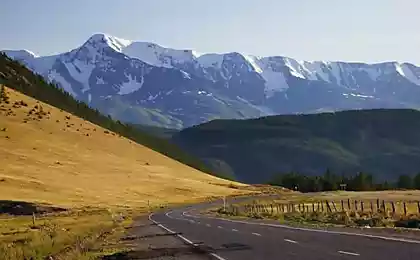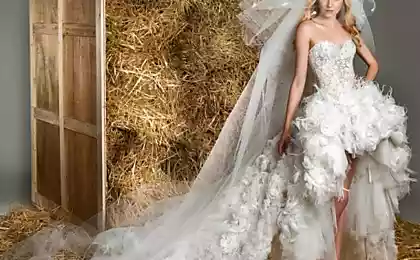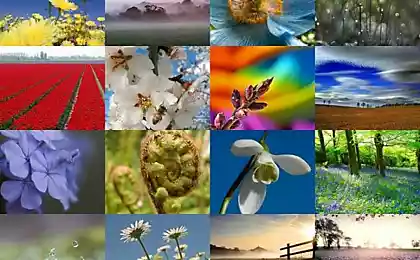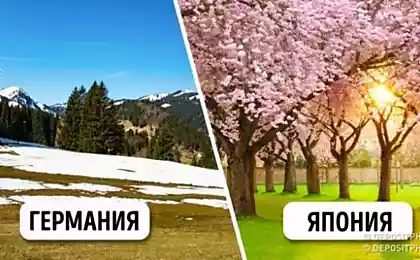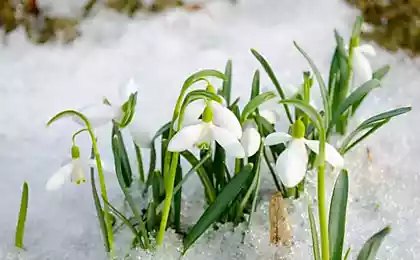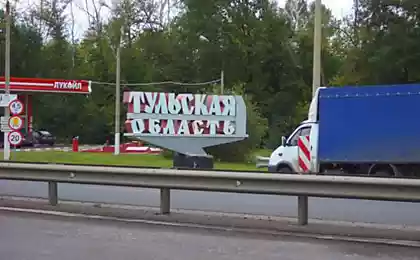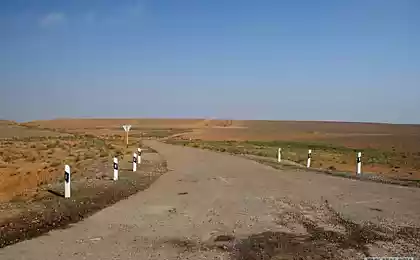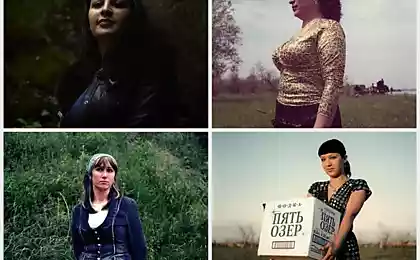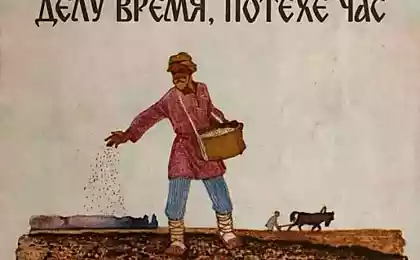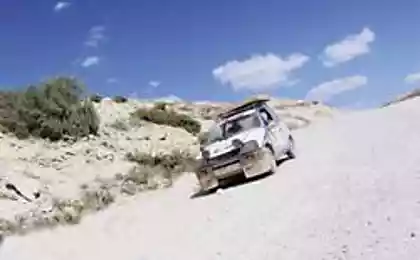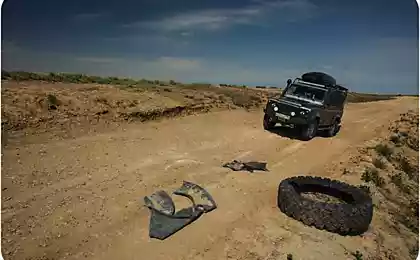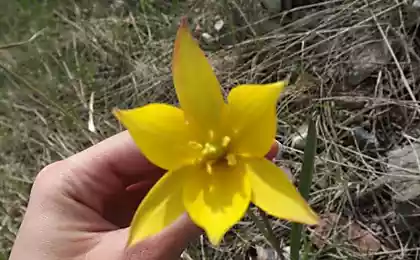1515
Kalmykia!
Preamble:
Republic of Kalmykia (Kalm. Khalmg Taңһch) - Republic, a subject of the Russian Federation, is part of the Southern Federal District. Capital - the city of Elista. Bordered on the south by the Republic of Dagestan, in the south-west - with the Stavropol Territory in the west - with the Rostov region, in the northwest - with the Volgograd region, in the east - the Astrakhan region.
The capital of the Republic of Kalmykia, Elista (from Kalm. Elst - sand) (in 1944-1957 Steppenwolf) - a city in southern Russia, the capital of Kalmykia, the largest city of the country. Located in the heart of the Kalmyk steppes, 1,250 kilometers southeast of Moscow. The most important economic, political and cultural center of Kalmykia
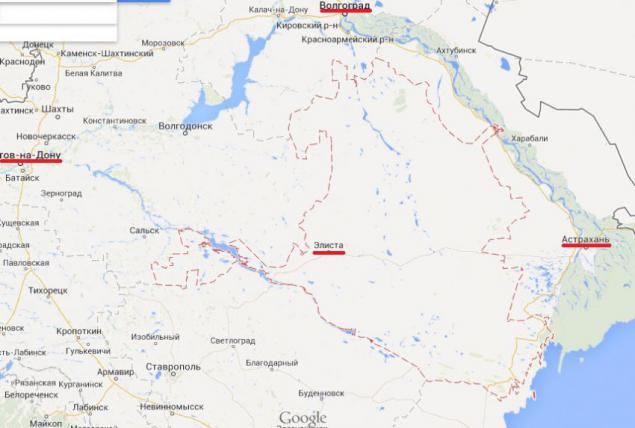
A little bit about what to see and Elista in Kalmykia, to describe all I'm not going to not strain you Anonymous, so I will describe the main.
Buddisky khurul - Golden Abode of Buddha Shakyamuni (Kalm. Burhn Bagshin altn sүm) - the largest Buddhist temple in the Republic of Kalmykia, one of the largest Buddhist temples in Europe. Located in central Elista
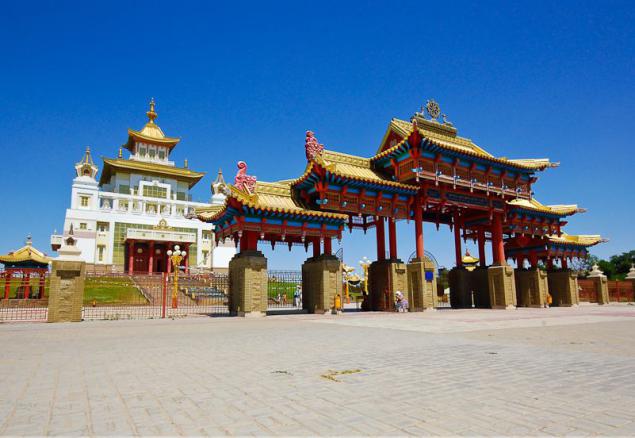
City Chess and Chess City - public and business, cultural and residential complex located south-east of Elisty.Postroen in connection with Elista XXXIII Chess Olympiad in 1998.
P.S. Interesting fact the road to City Chess is across the avenue Ostap Bender
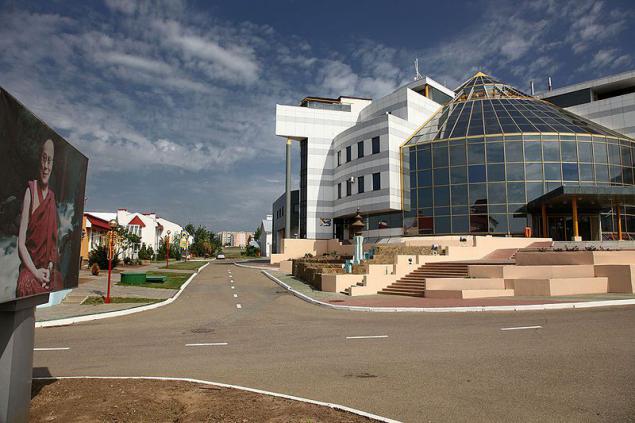
Well, respectively, and a monument to Ostap on the eponymous boulevard :)
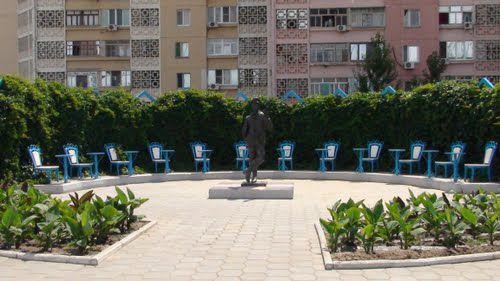
In the city center, it is the pearl of Elista and its decoration Pagoda seven days
The name of the pagoda is associated with seven Buddhas who came to our world. In the body of the pagoda placed prayer wheel diameter of 1, 2 meters and a height of 1, 8 meters. Drum was presented as a gift Kalmyk lamas Gyumed Tantric Monastery in India in the day of the 70th anniversary of His Holiness the Dalai Lama XIV. Drum weighs 2 tons and it marked in letters of gold lettering mantra "Om mani padme hum" in Tibetan, Sanskrit and the Kalmyk language alphabet todo-bichig. The drum is laid down 75 million mantra "Om Mani Padme Hum».
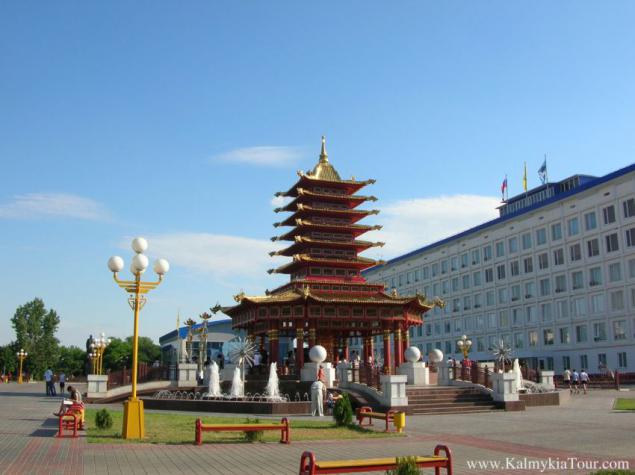
Near the pagoda is a fountain "Three lotus" and chessboard 5x5 meters. On this board, each resident or guest of the city can play chess for free.

Golden Gate (Kalm. Altn Bosch) - Buddhist architectural structure, height of the building is 15 meters. On the Golden Gate are 28 paintings illustrating the past history of the Kalmyk people.
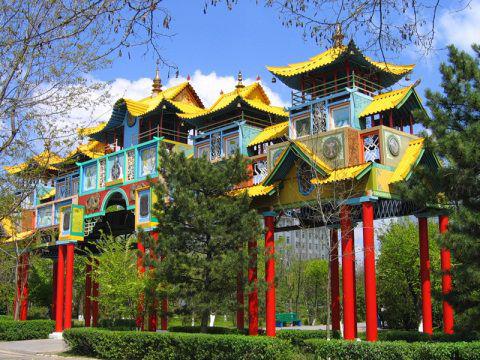
Alley of Heroes - the memorial complex in the center of the Avenue of Heroes is a monument to Lieutenant General BB Gorodovikova. Two walls of the memorial are the bas-reliefs of Heroes of the Soviet Union and Russia, the Hero of Socialist Labour, who in any way were related to Kalmykia. On the left wall are bas-reliefs of 37 Heroes of the Soviet Union and Russia, on the right wall - reliefs 36 Heroes of Socialist Labor.
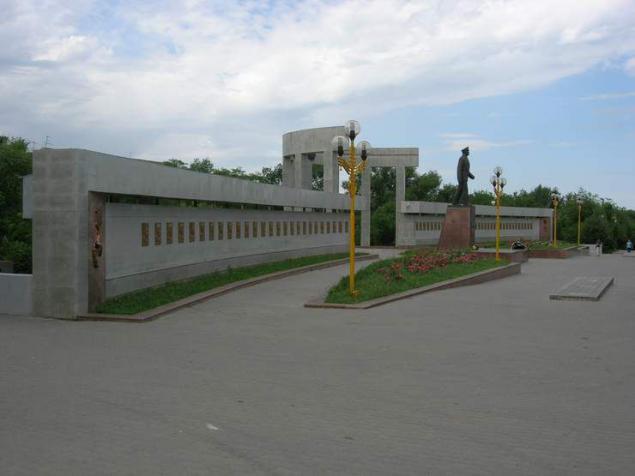
Another memorial is located in the park "Friendship" (Elista), is dedicated to those who died in the Civil War and the Great Patriotic War. The monument consists of three parts. The introductory part of the pylons are directed upwards, as symbols of three generations.

This is followed by a broad staircase leading directly to the area with burials and sculpture members of the Civil and the Great Patriotic War, residents of Elista and Kalmykia. Despite the fact that the sculpture was not detailed, clearly visible emotions on the faces of the people that make the monument more monumental and clear. Next to the memorial in the park "Friendship" is an eternal flame.
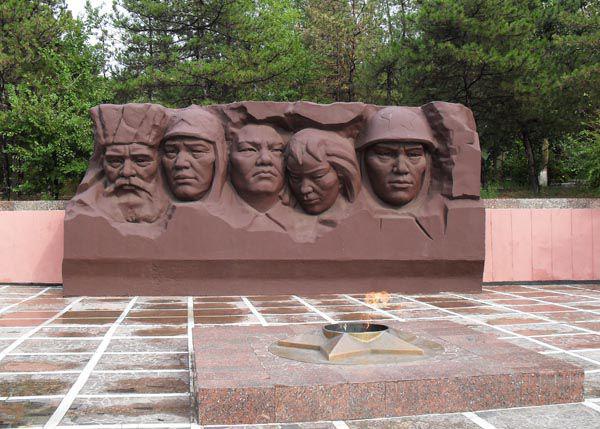
Other monuments in the park "Friendship" in Elista, is a man who has made a significant contribution to the folk art of the Kalmyk people - Eelyan Ovla. Biography of the Kalmyk-djangarchy narrator is not known, but it is fully justified by his work: the words were written Eelyana Ovly main Kalmyk folklore - "Dzhangar", which became the foundation of the poem. Monument djangarchy Eelyana Ovly in the park "Friendship" (Elista) is a storyteller, dressed in national costumes, with dombra in hand. Behind the monument - the stele with scenes from the epic song "Dzhangar».
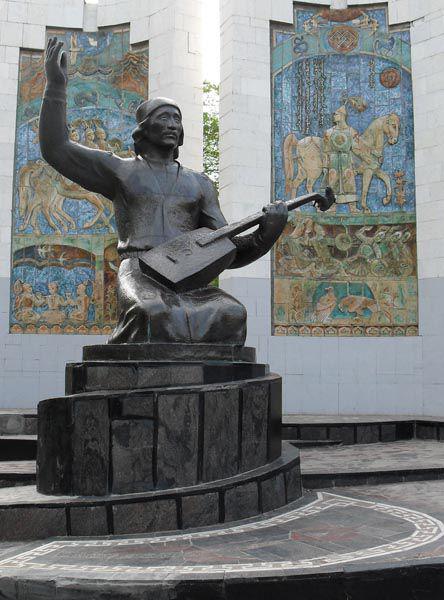
Notable is the figure of a white old man, which is located right there in the park "Friendship". White marble sculpture Tsagaan Aava, height of almost 3 meters, especially revered among the Kalmyks: Cagan Aav - the patron of all living things in the world, a symbol of unity and purity.
At the feet of the guardian of fertility and family welfare sit animals: saiga antelope and an eagle, personifying eternity and immortality of the universe, and the wolf as a symbol of integrity and perseverance. The monument was opened to white elder in Elista (the park "Friendship") in 1998.
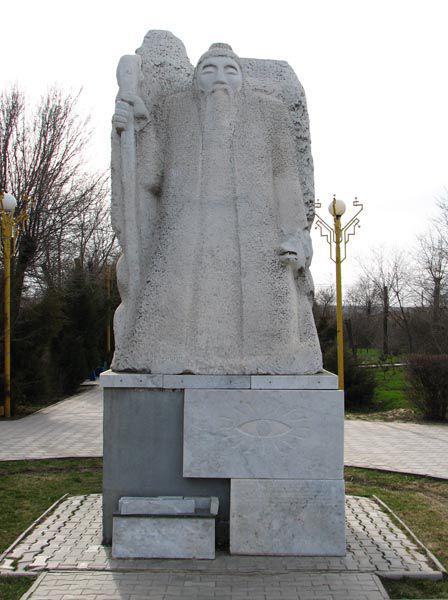
Echo (Kalm. Duurin) - one of the outdoor sculptures Elista, sculpture is made of bronze, the height of the sculpture is 3, 5 meters. The sculpture depicts djangarchy - Executive Kalmyk epic "Dzhangar" sitting in a characteristic pose djangarchy "sitting on his knees" (Kalm. Өvglөd) and playing the musical instrument variations Kalmyk dombra "Huur." Djangarchy gentle hug dombra, which is in the form of a through aperture represents a single sound of strings and epic performance of "Djangar" is the soul of the Kalmyk people. Dombra and epic "Dzhangar" sound like an echo of the Kalmyk people for centuries.
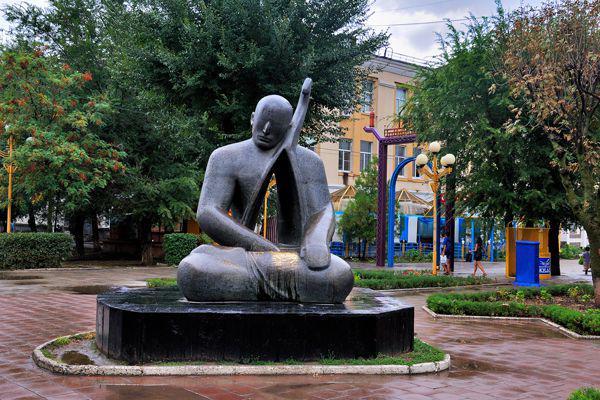
Exodus and Return (Kalm. Buslen Bolney Boskhlen) - a monument of Ernst Unknown authorship. Monument dedicated to the deportation of the Kalmyk people to Siberia.
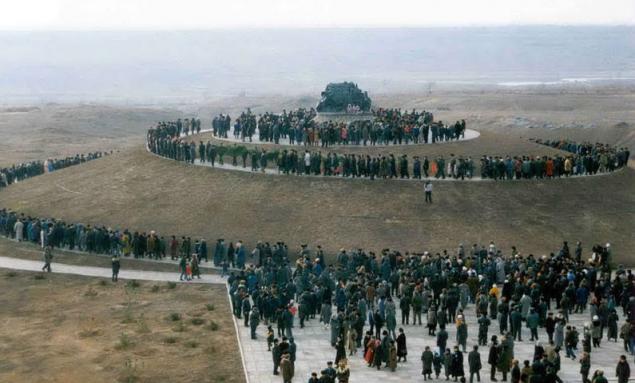
The memorial complex consists of several elements: the actual monument "Exodus and Return", standing on top of an artificially created mound, railcar and a plaque. The rise of the monument is performed along a spiral path that winds around clockwise mound, repeating the ritual bypass Buddhist temple khurul.
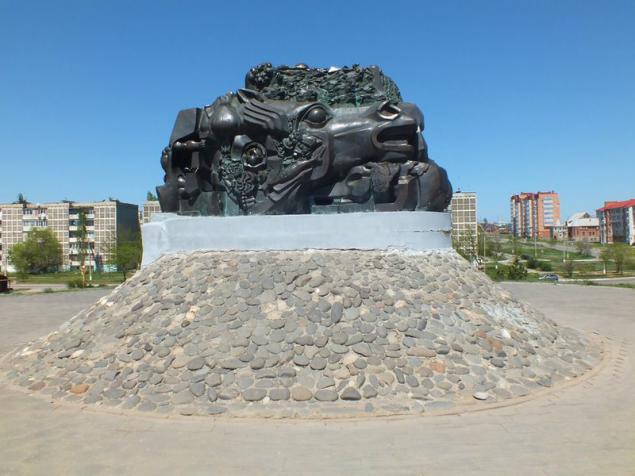
At the foot of the mound is a railway car, which transported the Kalmyks to Siberia. The car is on the track that lead to the mound. On the left side of the rails are 14 granite columns by the number of years (1943-1957 gg.), During which the Kalmyk people were in exile. At the end of the rail is a plaque with an excerpt from a poem by David Kugultinov with the words:
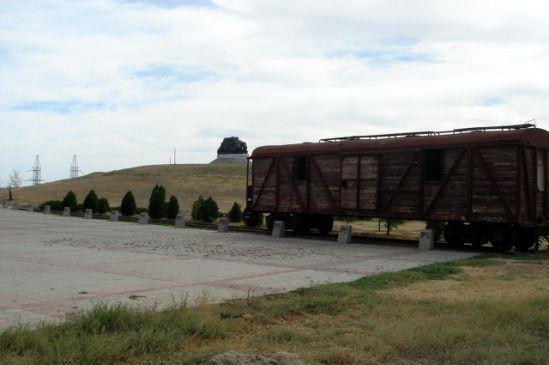
Golden rider monument, located in Elista, the work of sculptor Nicholas Rostov Mozhayeva was opened on May 1, 2007. Covered in gold leaf eight-meter monument is located on the 15-meter-high stele mounted on an artificial mound. The image of the "Golden Horseman" is taken from the Kalmyk folk epic "Dzhangar." The monument depicts a galloping horseman. In his right hand holding the banner of the rider, and the left - a Mongolian bow. On the left side of the rider flying hawk.
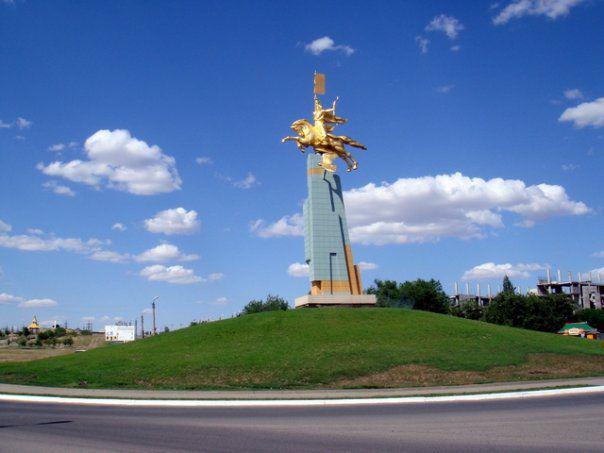
Saiga - one of the most remarkable steppe species, but the fate he got uneasy. The history of the saiga - like a seesaw. That he - the main object of hunting in the plains, it is on the verge of extinction, then again numerous herds.
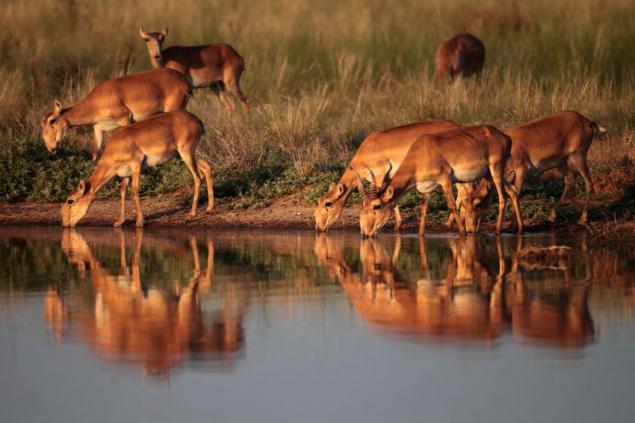
Caygak - medium-sized antelope, high on, light and agile. No one will confuse the Saiga because large head with bulging humped muzzle, ending like a little proboscis. Males - small translucent light with dark tips of the horns, females are hornless. The largest adult animals do not exceed 60 kg, on average, males are about 45 kg, and females - 30-35.
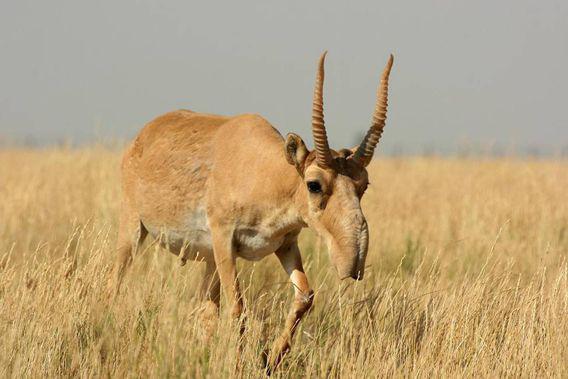
But in order to understand what the saiga - should not talk about a specific animal, as herds. The fact that migration thousandths herds of saiga - an amazing natural phenomenon. In the autumn, with the onset of winter, and especially - with snowfall - saiga gradually moved from the steppes to the south - where there is no snow, or - at least - it is much less. In summer, when the south grass burn and dry reservoirs, antelopes move north. The migrating herds can gather thousands, tens of thousands of animals, moving a continuous stream. In the spring, the birth of young animals, saiga are usually concentrated in traditional areas and to approach gradually the groups. Sometimes, the weather conditions are unfavorable, and the animals are forced to migrate in the spring - and then adult animals here and there you can see the tiny calves (2, 5-4 kg), who at the age of 3-4 days, trying to keep up with the moms. If this is not necessary, then the calves after birth the first 3-4 days is carried out mainly harboring - mum grazing around and occasionally suited to feed. After 10 days saygachenok has almost always follows the female.
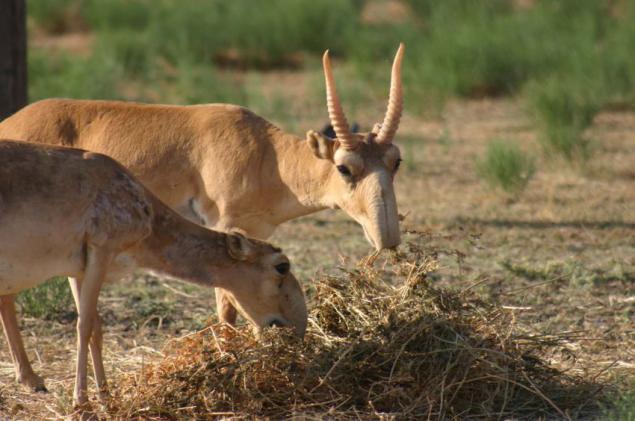
In the Kalmyk steppe tulips bloom in April. For residents of Kalmykia and the arrival of spring flowering tulips - are inseparable concepts.

Spring tulips covered steppe gradually. The first blooms dvuhtsvetkovy tulip (Tulipa biflora), followed by tulip blooms Bieberstein (Tulipa biebersteiniana) - popularly referred to as a bell because of the small yellow flowers.
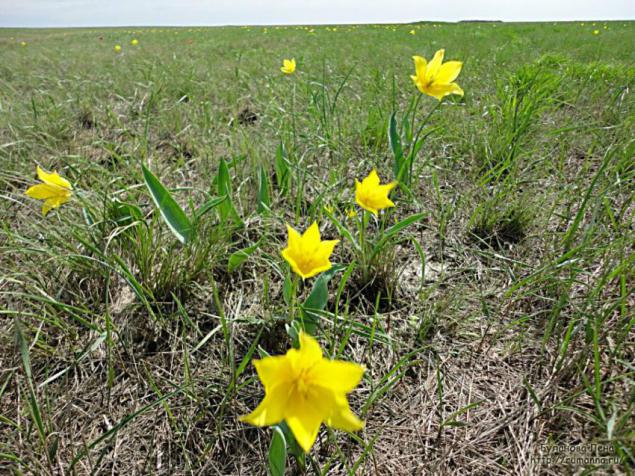
Finally, Schrenk tulip blossoms (Tulipa schrenkii), known to all of its bright red color. But it is the most diverse color: pink, yellow, purple, dark cherry and lilac.
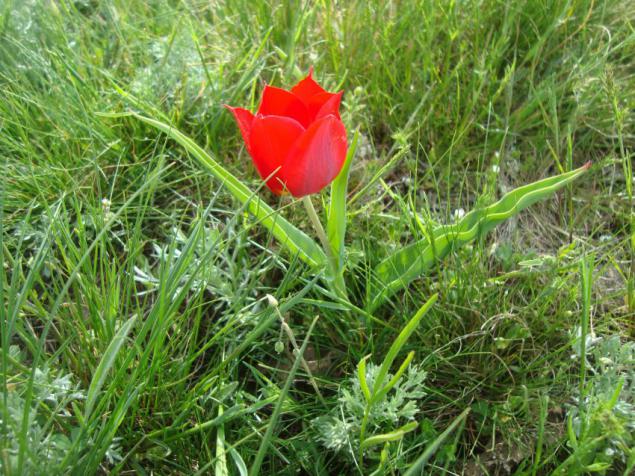
Profuse flowering occurs every two years and does not last long - only 8-10 days. It is noteworthy that even 30 years ago, wild tulips bloomed 20 days. This is a very undemanding plants that have adapted to alkaline soils of Kalmykia, well tolerate drought and winter drying soil.
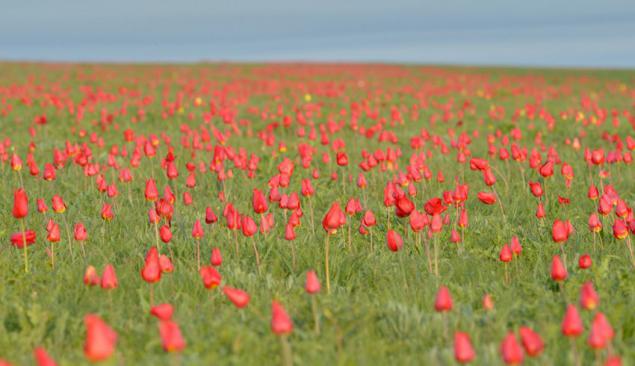
On peals - a unique place where the Volga flows into the Caspian Sea, from mid-July to mid-August and the middle of the water expanses riotous color blooming lotus (lily amazingly gentle colors - pink, cream, white).
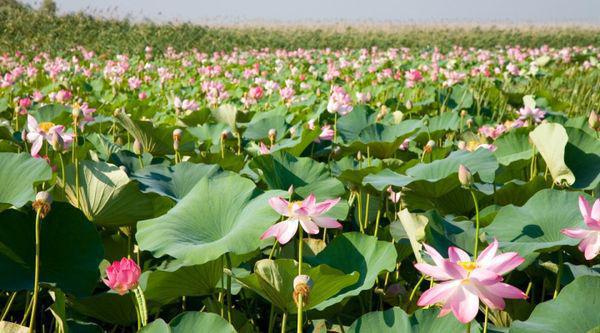
Lotus "flower of Buddha" is born in July, blooms only two or three days. Pluck it is impossible, and useless. Lotuses fade very quickly, plucked fresh bud zhuhnet before our eyes.
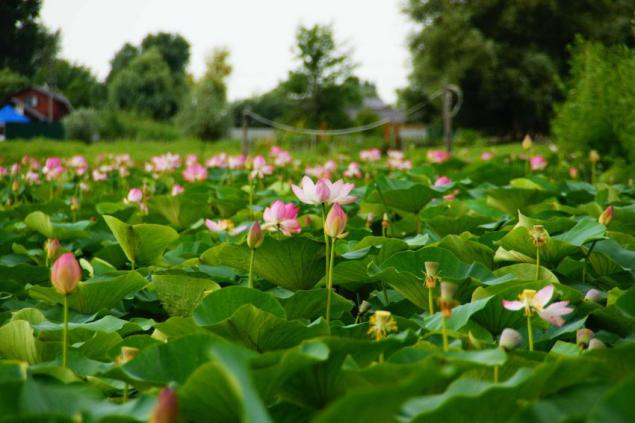
The first thing that strikes you when approaching a living carpet of bright lotus flowers - this amazing flavor of the lotus. Even if your sense of smell is not so perfect, they make delicious smell involuntarily plunge into the sweet slumber. Second - this is a huge amount of lotus flowers.

That's not a lot of what I wanted to tell. In this generation, and took his leave.
P.S. Now as time goes blooming tulips. And in Kalmykia conducted Tulip Festival.
www.facebook.com/TulipFest.ru
--img28--
Source:
Republic of Kalmykia (Kalm. Khalmg Taңһch) - Republic, a subject of the Russian Federation, is part of the Southern Federal District. Capital - the city of Elista. Bordered on the south by the Republic of Dagestan, in the south-west - with the Stavropol Territory in the west - with the Rostov region, in the northwest - with the Volgograd region, in the east - the Astrakhan region.
The capital of the Republic of Kalmykia, Elista (from Kalm. Elst - sand) (in 1944-1957 Steppenwolf) - a city in southern Russia, the capital of Kalmykia, the largest city of the country. Located in the heart of the Kalmyk steppes, 1,250 kilometers southeast of Moscow. The most important economic, political and cultural center of Kalmykia

A little bit about what to see and Elista in Kalmykia, to describe all I'm not going to not strain you Anonymous, so I will describe the main.
Buddisky khurul - Golden Abode of Buddha Shakyamuni (Kalm. Burhn Bagshin altn sүm) - the largest Buddhist temple in the Republic of Kalmykia, one of the largest Buddhist temples in Europe. Located in central Elista

City Chess and Chess City - public and business, cultural and residential complex located south-east of Elisty.Postroen in connection with Elista XXXIII Chess Olympiad in 1998.
P.S. Interesting fact the road to City Chess is across the avenue Ostap Bender

Well, respectively, and a monument to Ostap on the eponymous boulevard :)

In the city center, it is the pearl of Elista and its decoration Pagoda seven days
The name of the pagoda is associated with seven Buddhas who came to our world. In the body of the pagoda placed prayer wheel diameter of 1, 2 meters and a height of 1, 8 meters. Drum was presented as a gift Kalmyk lamas Gyumed Tantric Monastery in India in the day of the 70th anniversary of His Holiness the Dalai Lama XIV. Drum weighs 2 tons and it marked in letters of gold lettering mantra "Om mani padme hum" in Tibetan, Sanskrit and the Kalmyk language alphabet todo-bichig. The drum is laid down 75 million mantra "Om Mani Padme Hum».

Near the pagoda is a fountain "Three lotus" and chessboard 5x5 meters. On this board, each resident or guest of the city can play chess for free.

Golden Gate (Kalm. Altn Bosch) - Buddhist architectural structure, height of the building is 15 meters. On the Golden Gate are 28 paintings illustrating the past history of the Kalmyk people.

Alley of Heroes - the memorial complex in the center of the Avenue of Heroes is a monument to Lieutenant General BB Gorodovikova. Two walls of the memorial are the bas-reliefs of Heroes of the Soviet Union and Russia, the Hero of Socialist Labour, who in any way were related to Kalmykia. On the left wall are bas-reliefs of 37 Heroes of the Soviet Union and Russia, on the right wall - reliefs 36 Heroes of Socialist Labor.

Another memorial is located in the park "Friendship" (Elista), is dedicated to those who died in the Civil War and the Great Patriotic War. The monument consists of three parts. The introductory part of the pylons are directed upwards, as symbols of three generations.

This is followed by a broad staircase leading directly to the area with burials and sculpture members of the Civil and the Great Patriotic War, residents of Elista and Kalmykia. Despite the fact that the sculpture was not detailed, clearly visible emotions on the faces of the people that make the monument more monumental and clear. Next to the memorial in the park "Friendship" is an eternal flame.

Other monuments in the park "Friendship" in Elista, is a man who has made a significant contribution to the folk art of the Kalmyk people - Eelyan Ovla. Biography of the Kalmyk-djangarchy narrator is not known, but it is fully justified by his work: the words were written Eelyana Ovly main Kalmyk folklore - "Dzhangar", which became the foundation of the poem. Monument djangarchy Eelyana Ovly in the park "Friendship" (Elista) is a storyteller, dressed in national costumes, with dombra in hand. Behind the monument - the stele with scenes from the epic song "Dzhangar».

Notable is the figure of a white old man, which is located right there in the park "Friendship". White marble sculpture Tsagaan Aava, height of almost 3 meters, especially revered among the Kalmyks: Cagan Aav - the patron of all living things in the world, a symbol of unity and purity.
At the feet of the guardian of fertility and family welfare sit animals: saiga antelope and an eagle, personifying eternity and immortality of the universe, and the wolf as a symbol of integrity and perseverance. The monument was opened to white elder in Elista (the park "Friendship") in 1998.

Echo (Kalm. Duurin) - one of the outdoor sculptures Elista, sculpture is made of bronze, the height of the sculpture is 3, 5 meters. The sculpture depicts djangarchy - Executive Kalmyk epic "Dzhangar" sitting in a characteristic pose djangarchy "sitting on his knees" (Kalm. Өvglөd) and playing the musical instrument variations Kalmyk dombra "Huur." Djangarchy gentle hug dombra, which is in the form of a through aperture represents a single sound of strings and epic performance of "Djangar" is the soul of the Kalmyk people. Dombra and epic "Dzhangar" sound like an echo of the Kalmyk people for centuries.

Exodus and Return (Kalm. Buslen Bolney Boskhlen) - a monument of Ernst Unknown authorship. Monument dedicated to the deportation of the Kalmyk people to Siberia.

The memorial complex consists of several elements: the actual monument "Exodus and Return", standing on top of an artificially created mound, railcar and a plaque. The rise of the monument is performed along a spiral path that winds around clockwise mound, repeating the ritual bypass Buddhist temple khurul.

At the foot of the mound is a railway car, which transported the Kalmyks to Siberia. The car is on the track that lead to the mound. On the left side of the rails are 14 granite columns by the number of years (1943-1957 gg.), During which the Kalmyk people were in exile. At the end of the rail is a plaque with an excerpt from a poem by David Kugultinov with the words:

Golden rider monument, located in Elista, the work of sculptor Nicholas Rostov Mozhayeva was opened on May 1, 2007. Covered in gold leaf eight-meter monument is located on the 15-meter-high stele mounted on an artificial mound. The image of the "Golden Horseman" is taken from the Kalmyk folk epic "Dzhangar." The monument depicts a galloping horseman. In his right hand holding the banner of the rider, and the left - a Mongolian bow. On the left side of the rider flying hawk.

Saiga - one of the most remarkable steppe species, but the fate he got uneasy. The history of the saiga - like a seesaw. That he - the main object of hunting in the plains, it is on the verge of extinction, then again numerous herds.

Caygak - medium-sized antelope, high on, light and agile. No one will confuse the Saiga because large head with bulging humped muzzle, ending like a little proboscis. Males - small translucent light with dark tips of the horns, females are hornless. The largest adult animals do not exceed 60 kg, on average, males are about 45 kg, and females - 30-35.

But in order to understand what the saiga - should not talk about a specific animal, as herds. The fact that migration thousandths herds of saiga - an amazing natural phenomenon. In the autumn, with the onset of winter, and especially - with snowfall - saiga gradually moved from the steppes to the south - where there is no snow, or - at least - it is much less. In summer, when the south grass burn and dry reservoirs, antelopes move north. The migrating herds can gather thousands, tens of thousands of animals, moving a continuous stream. In the spring, the birth of young animals, saiga are usually concentrated in traditional areas and to approach gradually the groups. Sometimes, the weather conditions are unfavorable, and the animals are forced to migrate in the spring - and then adult animals here and there you can see the tiny calves (2, 5-4 kg), who at the age of 3-4 days, trying to keep up with the moms. If this is not necessary, then the calves after birth the first 3-4 days is carried out mainly harboring - mum grazing around and occasionally suited to feed. After 10 days saygachenok has almost always follows the female.

In the Kalmyk steppe tulips bloom in April. For residents of Kalmykia and the arrival of spring flowering tulips - are inseparable concepts.

Spring tulips covered steppe gradually. The first blooms dvuhtsvetkovy tulip (Tulipa biflora), followed by tulip blooms Bieberstein (Tulipa biebersteiniana) - popularly referred to as a bell because of the small yellow flowers.

Finally, Schrenk tulip blossoms (Tulipa schrenkii), known to all of its bright red color. But it is the most diverse color: pink, yellow, purple, dark cherry and lilac.

Profuse flowering occurs every two years and does not last long - only 8-10 days. It is noteworthy that even 30 years ago, wild tulips bloomed 20 days. This is a very undemanding plants that have adapted to alkaline soils of Kalmykia, well tolerate drought and winter drying soil.

On peals - a unique place where the Volga flows into the Caspian Sea, from mid-July to mid-August and the middle of the water expanses riotous color blooming lotus (lily amazingly gentle colors - pink, cream, white).

Lotus "flower of Buddha" is born in July, blooms only two or three days. Pluck it is impossible, and useless. Lotuses fade very quickly, plucked fresh bud zhuhnet before our eyes.

The first thing that strikes you when approaching a living carpet of bright lotus flowers - this amazing flavor of the lotus. Even if your sense of smell is not so perfect, they make delicious smell involuntarily plunge into the sweet slumber. Second - this is a huge amount of lotus flowers.

That's not a lot of what I wanted to tell. In this generation, and took his leave.
P.S. Now as time goes blooming tulips. And in Kalmykia conducted Tulip Festival.
www.facebook.com/TulipFest.ru
--img28--
Source:
